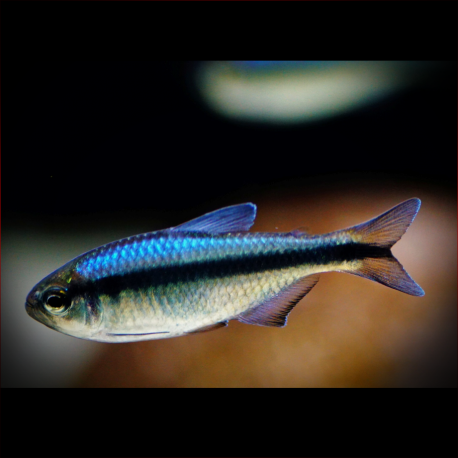More info
Datasheet
| Minimum Tank Size | 54 litres / 14.27 US gallons |
| Maximum Size | 2.5cm / 0.98inches |
| Temperature | 23°C / 73.40°F - 28°C / 82.40°F |
| Hardness | 0.00dgH / 0ppm - 10.03dgH / 179ppm |
| pH | 5.5-7.5 |
General Description
Hyphessobrycon melanostichos, commonly known as the Black Stripe Tetra, is a species within the Characidae family. This fish typically grows up to 2.5cm in length and is native to the Rio Doze de Outubro of the upper Rio Tapajos basin in Brazil. It shares similarities with Hyphessobrycon sp. Blue Ribbon but can be distinguished by its lighter and more streamlined body with a smaller humeral spot and red coloring absent in the Blue Ribbon Tetra. The species is named for the black longitudinal stripe running along its body.
Aquarium Setup
For optimal aquarium setup, it is recommended to house H. melanostichos in larger groups of 10 or more individuals to prevent territorial behavior issues, especially in smaller tanks. A tank size of 54 liters or larger is suitable, with a preference for a group of 12+ in a 90cm long tank for harmonious dynamics. Decorate the tank with lush plant growth, rounded cobbles, sandy substrate, driftwood, and leaf litter. Presence of mosses in the tank may lead to sightings of fry and young fish offspring. Water parameters should be maintained at pH levels of 5.5-7.5, hardness between 0-179 ppm, and a temperature range of 23-28°C.
Behaviour
H. melanostichos displays territorial tendencies in smaller aquariums or those with well-defined boundaries. In larger groups, individuals form loose hierarchies, with rival males engaging in battles for female attention and positioning within the group. Males exhibit enhanced coloration in the presence of rivals. Despite territorial behavior, these fish show minimal aggression towards other species in larger tanks, although caution is advised with long-finned tankmates. Suitable tank mates include robust fishes from similar biotopes, such as certain characids, gasteropelecids, lebiasinids, smaller callichthyid or loricariid catfishes, and small-to-medium sized cichlids.
Feeding and Diet
The Black Stripe Tetra is likely omnivorous, feeding on small invertebrates, crustaceans, filamentous algae, and fallen fruit in the wild. In captivity, they can survive on dried foods but thrive on a varied diet that includes live and frozen foods like chironomid larvae, bloodworms, mosquito larvae, Daphnia, and Moina. Providing a diverse menu ensures their nutritional needs are met.
Reproduction & Dimorphism
H. melanostichos is an egg-scattering free spawner that exhibits no parental care. Spawning occurs frequently in mature aquariums, with fry appearing without intervention in optimal conditions. Controlled breeding methods involve conditioning males and females separately in slightly cooler water conditions. Spawning substrates such as mesh, grass matting, or fine-leaved plants are utilized to collect eggs. Males display darker colors during courtship, while females may appear deeper bodied, particularly when gravid.
Habitat and Distribution
Endemic to the Rio Doze de Outubro in Brazil, H. melanostichos thrives in similar water conditions found in its natural habitat. A similar species, Hyphessobrycon cf. melanostichos, is found in the Rio Teles Pires region. These fish prefer habitats with neutral to slightly acidic pH levels and temperatures ranging from 23-28°C. Providing an environment that mimics their native waters promotes their health and well-being.

